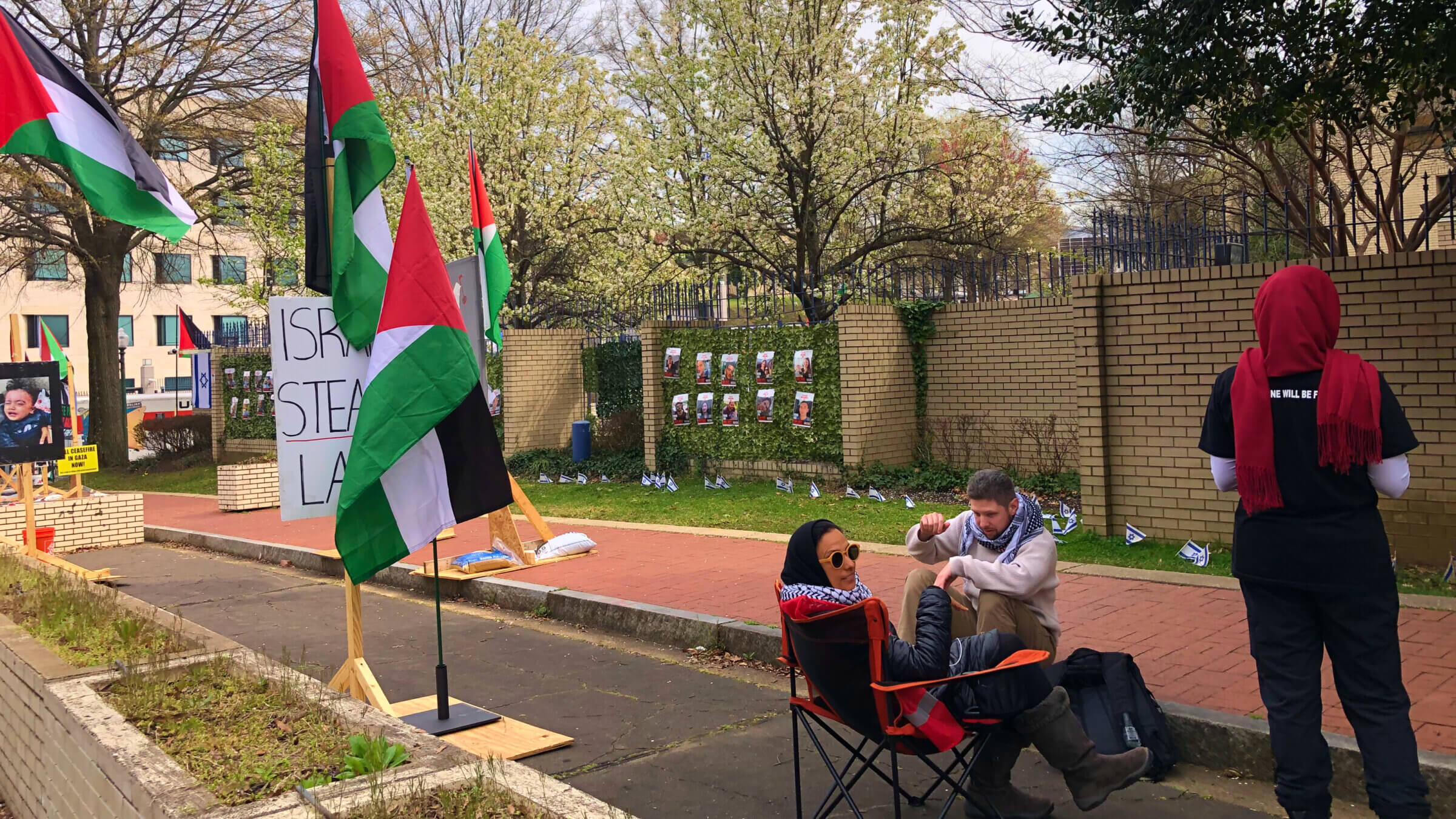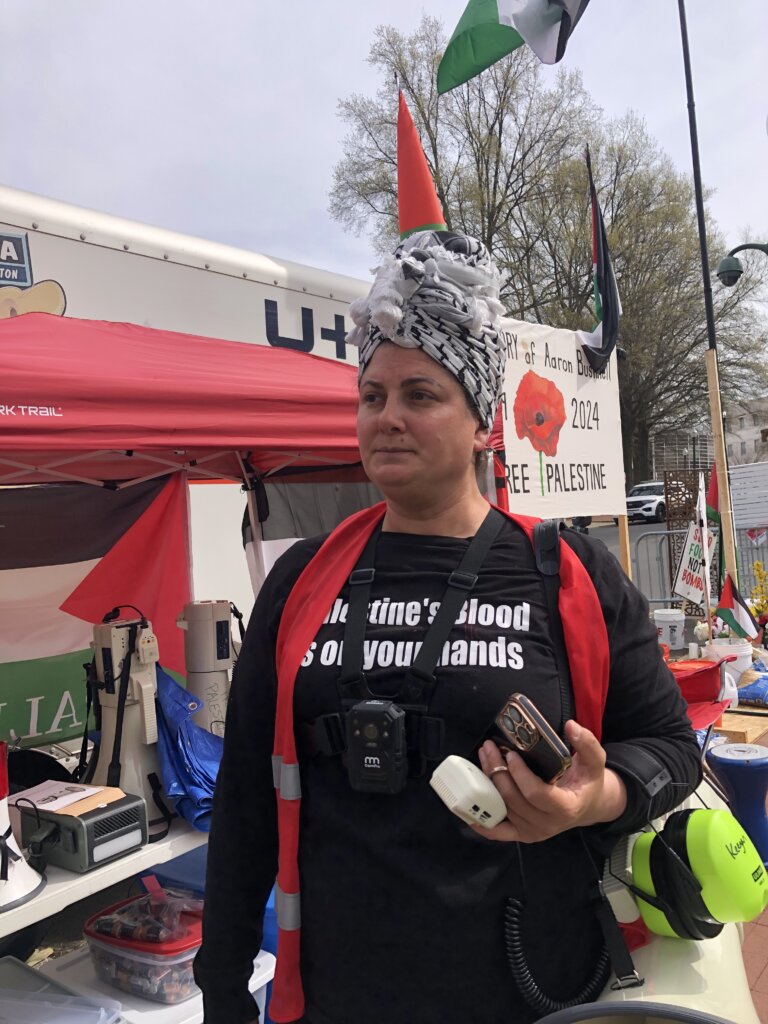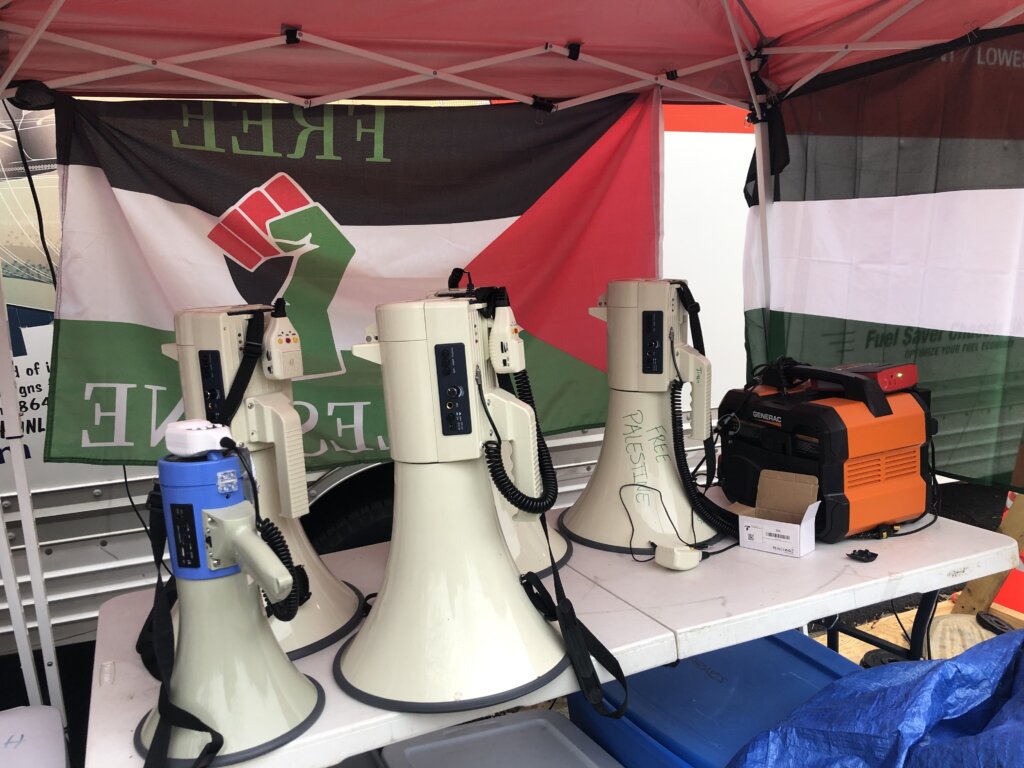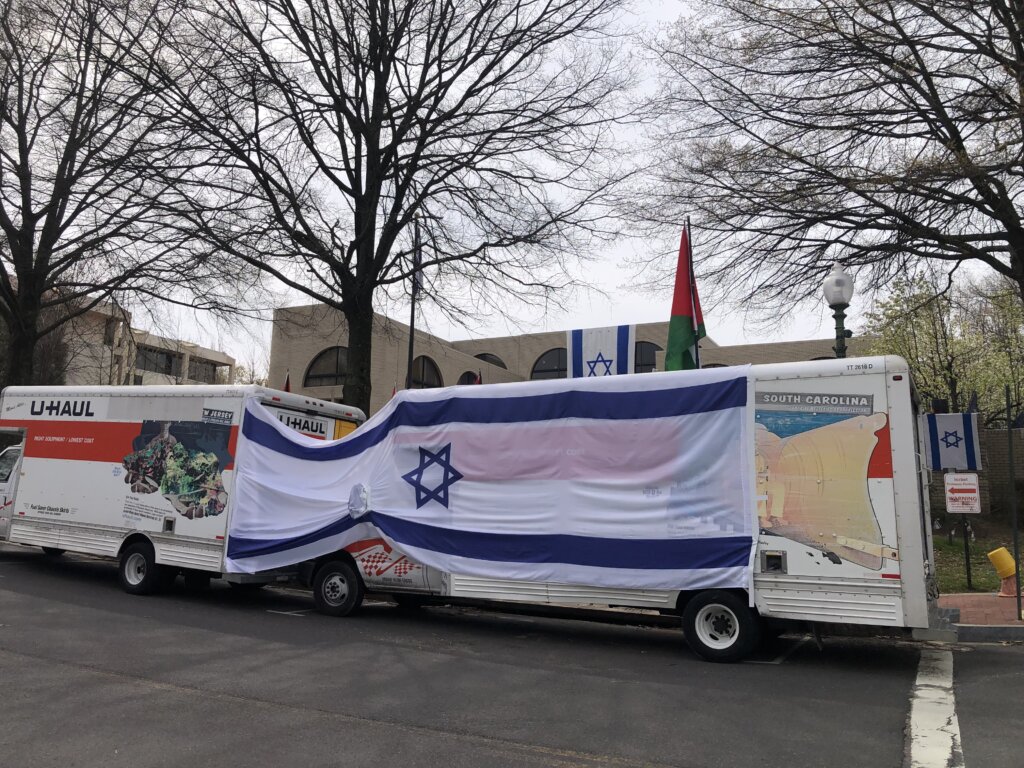‘Until a ceasefire’: Nonstop protest rocks the Israeli Embassy — and the neighborhood beyond
For the past month, protesters have maintained a constant presence outside the embassy in Washington

Protesters have maintained a constant presence outside the Israeli Embassy in Washington, D.C., for the past month. Photo by Lauren Markoe
The protesters point their megaphones toward the Israeli embassy every morning, and blast the sound of a siren so loud it can be heard a block away. Sometimes they also yell into microphones: “Wicked!” “Racist!” and “Shame on you!”
On Wednesday, at least one protester wore earplugs.
Outside the embassy’s main entrance, the protesters have dug in. They’ve stockpiled audio equipment, body cams and snacks on tables and in labeled plastic bins. Each night a new shift of protesters arrives. They silence the sirens, and sit in lawn chairs near a makeshift memorial of candles and flowers dedicated to Aaron Bushnell, the U.S. Airman who died after setting himself on fire in the embassy’s driveway a month ago while shouting “Free Palestine.”
A year ago, the embassy, in a mostly residential neighborhood in Washington, D.C., had been the site of intermittent protests of Jews upset with a package of judicial bills backed by Israel’s right-wing government. But for the past month, since Bushnell’s death, the protests at the embassy — this time over the war — have never ended.
Outside the Israeli Embassy. Warning: Video includes graphic images.
More than 30 Palestinian flags, and posters of maimed children with the slogan “Israel Bombs Babies” and “Israel Steals Land,” dominate the sidewalks in front of and to the side of the building.
Protesters say they are careful not to violate rules about demonstrating. But Wednesday morning, one protester did: Secret Service officers arrested her after she chalked “Embassy of Genocide” on a part of the sidewalk cordoned off with police tape. After they drove her away, another protester played on a drum set in front of the embassy.

Asked Wednesday how long she and others had been protesting, Hazami Barmada, 40, said “Four weeks, 24/7″ — since Bushnell’s self-immolation.
How long do they plan to continue? “Until a ceasefire.”
Officers outnumber protesters

Protesters — usually fewer than 10 at a time — maintain a presence on the sidewalks outside the embassy day and night, when they turn the sirens off. It’s a particularly staunch outpost of the protests against Israel’s war in Gaza — a response to the Oct. 7 attack in which Hamas killed 1,200 and took 240 hostage in Israel — that have swept the U.S. Israel’s military campaign has killed more than an estimated 32,000 Palestinians, according to the Gaza health ministry.
Most, but not all, of the protesters are young, and wear keffiyehs, or T-shirts proclaiming their allegiance to the Palestinian cause. Some wear body cams — to record counterprotesters who have shown up and have sometimes harassed them, they said.
The constant protests have prompted both the Secret Service and the city’s police department to increase their presence outside the embassy. About seven of them patrolled close to the protesters Wednesday morning. At times, officers outnumber protesters.
Barmada, whose family is from Nablus in the West Bank, was one of the few protesters who agreed to speak with me over three days of visits to the embassy. She said the protesters are from a “grassroots” group, but did not want to share that group’s name. She said she has visited the West Bank and seen the harassment her mother has endured from Israelis.
“Every single person in this world, including Palestinians, should have access to freedom and justice and liberties that we want for your own kids, my own kids,” she said.
The organized protesters’ signs and slogans accuse Israel — not Jews — of genocide and land theft. But the protest has also attracted some who support the Palestinian cause who are also promoting other beliefs, including one man who shows up wearing a MAGA hat, and another who held up a sign on Wednesday that proclaimed “Jewish people tried to kill in a guy in a wheelchair with a machete.” In an interview, he spouted conspiracy theories about Jews.
Noise complaints and lacking nuance
The embassy protests may stand little chance of affecting the course of war; a top Israeli official recently said the war would continue “even if the entire world turns on Israel, including the United States.” It’s a little easier to gauge its impact within the neighborhood.
Many drivers see the protesters on Van Ness Street, on a hill that runs along the embassy’s north side. Some oblige their requests to honk for Palestine. But those who don’t regularly pass the embassy — and there are more pleasant, scenic blocks for walking nearby — are likely not aware of it.

Ronald Iannotti, a recently retired psychologist who lives within a mile of the embassy, called the protest “reasonable” Wednesday as he walked past the back of the building, where there were few posters and no protesters at the time. “Israel is taking it too far,” he said of the war. “Civilians are involved. They don’t seem to care.”
A Jewish neighbor walking to work that same morning, who spoke on the condition of anonymity for fear of retribution, said he starts hearing the protest about 7 a.m. each morning and it bothers him. Even though he opposes the policies of Israeli President Benjamin Netanyahu, he said, he doesn’t feel “safe” as a Jew around the protesters, saying their understanding of the conflict seems to lack nuance.
“It’s a lot of sound and noise, but you realize there’s very few people there,” he added.

The Israeli Embassy did not respond to questions about the protest.
Photos of hostages still held by Hamas cover the gates in front of the embassy, only a step or two from the protesters. Four U-Haul trucks have been parked in front of the building for days — it’s not clear how many — partially obscuring some of the protesters’ Palestinian flags. Strung across parts of two of those trucks is a giant Israeli flag.
A large black SUV with diplomatic plates sits in the embassy’s driveway, on the site of Bushnell’s self-immolation. A group of three women who were sitting near the makeshift memorial to him on Monday night said part of the reason they were there was to guard it, because the first memorial to him had been cleared away shortly after his death.
Matt Frumin, who represents the neighborhoods around the embassy on the City Council, said he has received complaints “pretty consistently” about the noise level from neighbors, and also from people affiliated with the University of the District of Columbia across Van Ness Street.
More intense concerns, he said, come from those who live near the Israeli ambassador’s residence, which sits in a leafy neighborhood that is also in his district, about a mile away. The protests there, he said, while more intermittent, have prevented some constituents from leaving their homes.
“There is this question of what goes over the line,” he said.

















